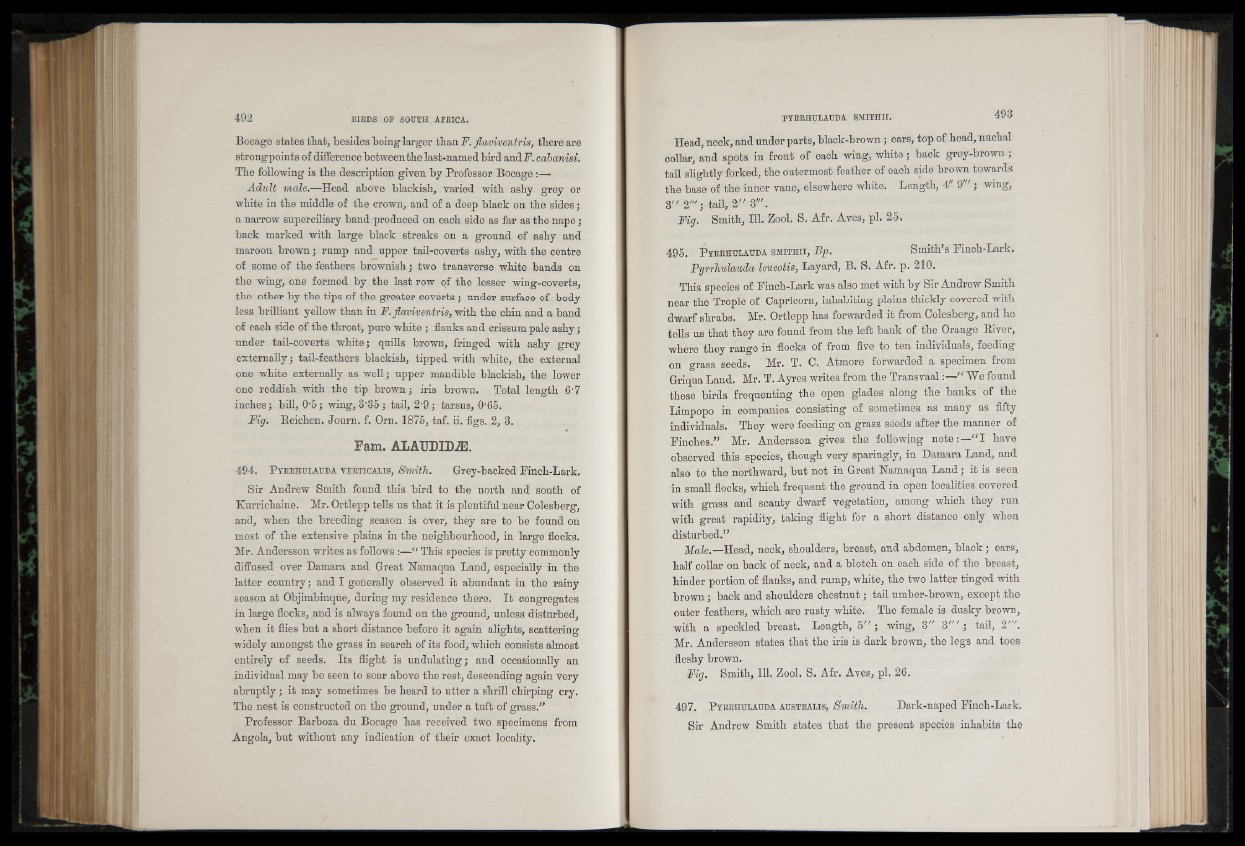
Bocage states that, besides being larger than F. jlaviventris, there are
strongpoints of difference between the last-named bird and F. cabanisi.
The following is the description given by Professor Bocage:—•
Adult male.—Head above blackish, varied with ashy grey or
white in the middle of the crown, and of a deep black on the sides;
a narrow superciliary band produced on each side as far as the nape;
back marked with large black streaks on a ground of ashy and
maroon brown; rump and upper tail-coverts ashy, with the centre
of some of the feathers brownish; two transverse white bands on
the wing, one formed by the last row of the lesser wing-coverts,
the other by the tips of the greater coverts; under surface of body
less brilliant yellow than in F. jlaviventris, with the chin and a band
of each side of the throat, pure white ; flanks and crissum pale ashy;
under tail-coverts white; quills brown, fringed with ashy grey
externally; tail-feathers blackish, tipped with white, the external
one white externally as well; upper mandible blackish, the lower
one reddish with the tip brown; iris brown. Total length 6'7
inches; bill, 0'5; wing, 3'35; tail, 2'9; tarsus, 0‘65.
Fig. Beichen. Journ. f. Orn. 1875, taf. ii. figs. 2, 3.
Fam. ALAUDID2E.
494. P yrrhulauda vertica lis , Smith. Grey-backed Finch-Lark.
Sir Andrew Smith found this bird to the north and south of
Kurrichaine. Mr. Ortlepp tells us that it is plentiful near Oolesberg,
and, when the breeding season is over, they are to be found on
most of the extensive plains in the neighbourhood, in large flocks.
Mr. Andersson writes as follows :—“ This species is pretty commonly
diffused over Damara and Great Namaqua Land, especially in the
latter country; and I generally observed it abundant in the rainy
season at Objimbinque, during my residence there. I t congregates
in large flocks, and is always found on the ground, unless disturbed,
when it flies but a short distance before it again alights, scattering
widely amongst the grass in search of its food, which consists almost
entirely of seeds. Its flight is undulating; and occasionally an
individual may be seen to soar above the rest, descending again very
abruptly; it may sometimes be heard to utter a shrill chirping cry.
The nest is constructed on the ground, under a tuft of grass.”
Professor Barboza du Bocage has received two specimens from
Angola, but without any indication of their exact locality,
Head, neck, and under parts, black-brown; ears, top of head, nuchal
collar, and spots in front of each wing, white; back grey-brown ;
tail slightly forked, the outermost feather of each side brown towards
the base of the inner vane, elsewhere white. Length, 4" 9" '; wing,
3" 2'"; tail, 2" 3'".
Fig. Smith, 111. Zool. S. Afr. Aves, pi. 25.
495. P yrrhulauda sm it h i i , Bp. Smith’s Finch-Lark.
Pyrrhidauda leucotis, Layard, B. S. Afr. p. 210.
This species of Finch-Lark was also met with by Sir Andrew Smith
near the Tropic of Capricorn, inhabiting plains thickly covered with
dwarf shrubs. Mr. Ortlepp has forwarded it from Colesberg, and he
tells us that they are found from the left bank of the Orange River,
where they range in flocks of from five to ten individuals, feeding
on grass seeds. h!r. T. 0. Atmore forwarded a specimen from
Griqua Land. Mr. T. Ayres writes from the Transvaal:—“ We found
these birds frequenting the open glades along the banks of the
Limpopo in eompanies consisting of sometimes as many as fifty
individuals. They were feeding on grass seeds after the manner of
Finches.” Mr. Andersson gives the following note:—“ I have
observed this species, though very sparingly, in Damara Land, and
also to the northward, but not in Great Namaqua Land; it is seen
in small flocks, which frequent the ground in open localities covered
with grass and scanty dwarf vegetation, among which they run
with great rapidity, taking flight for a short distance only when
disturbed.”
Male.—Head, neck, shoulders, breast, and abdomen, black; ears,
half collar on back of neck, and a blotch on each side of the breast,
hinder portion of flanks, and rump, white, the two latter tinged with
brown; back and shoulders chestnut; tail umber-brown, except the
outer feathers, which are rusty white. The female is dusky brown,
with a speckled breast. Length, 5 " ; wing, 3” 3 '" ; tail, 2"'.
Mr. Andersson states that the iris is dark brown, the legs and toes
fleshy brown.
Fig. Smith, 111. Zool. S. Afr. Aves, pi. 26.
497, P yrrhulauda australis, Smith. Dark-naped Finch-Lark.
Sir Andrew Smith states that the present species inhabits the